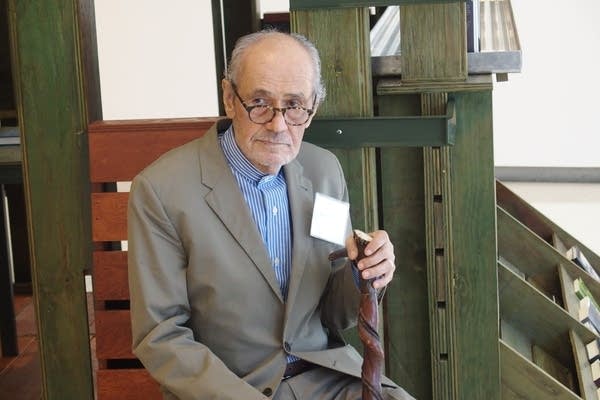The complex connections of Siah Armajani

Go Deeper.
Create an account or log in to save stories.
Like this?
Thanks for liking this story! We have added it to a list of your favorite stories.
If you've ever walked high above Interstate 94 on the brightly colored pedestrian bridge that links Loring Park with the Minneapolis sculpture garden, you've experienced the work of internationally acclaimed Twin Cities artist Siah Armajani.
He is known for his structures. Now a major new retrospective opening this weekend at the Walker Art Center explores the many other art forms entwined in his long career.
Senior curator Siri Engberg said Armajani is best known for "works of public art: bridges, gazebos, gardens, reading rooms, sited across the United States and Europe."
He also designed the Olympic cauldron for the Atlanta Games in 1996. But the public work is just a fraction of his output. He's a painter, a writer, a designer, an architect and a sculptor, amongst other things.
Turn Up Your Support
MPR News helps you turn down the noise and build shared understanding. Turn up your support for this public resource and keep trusted journalism accessible to all.
The Walker show is called "Siah Armajani: Follow This Line." The museum's assistant curator Victoria Sung says the name comes from Armajani's boyhood in the Iranian capital, Tehran.

"He and his classmates would take pencils and scrape them along the walls of the city as they were walking home from school," Sung said. And just as it was possible to follow those lines through the city, it's possible to follow Armajani's diverse interests through his work.
"Throughout that entire journey, Siah's practice encompasses poetry and philosophy, mathematics, computing, history and politics. So, it's a really lovely, meandering, winding, journey that we really encourage you to come on with us," Sung explained.
And on this day "us" included Armajani himself. He's notoriously shy, and rarely grants interviews. With his wife Barbara, the architect joined the small gaggle of arts reporters walking around the preview. He's 79 now and his voice gives out sometimes. When asked questions he usually smiled and then either shook or nodded his head.

Curator Sung showed examples of Armajani's early political paintings from the late 1950s when a U.S.-aided uprising led to the installation of Mohammad Reza Pahlavi, the Shah of Iran. Sung said Armajani joined the opposition.
"Fearing for his safety his father sent him to the U.S., and to the Twin Cities in particular, where his uncle, Yahya Armajani, was the chair of the history department at Macalester College," she said.
Once the young Siah moved to Minnesota in 1960, he quickly began producing art. One of the first pieces in the Walker exhibit is a huge canvas covered in illustrated Farsi script. It's called "Letters Home," and it's made of the actual letters he sent to his family back in Iran. It's the beginning of another line running through Armajani's work: an exile's view of the world.

Nearby there's a work made from the lining of a coat. Up close, visitors see it's also covered in Farsi, references to the artist's boyhood. The coat belonged to Armajani's father, said assistant curator Clare Davies, with the Metropolitan Museum of Art in New York where the show will travel next.
"You can see fairy tales, songs written by children, or poems," she said. "I am listing the kinds of forms of language that recur in his work."
And the work kept coming: There are 150 architectural models Armajani made for what he called "Dictionary of Building." There are plans for a tower which would cast a shadow across the entire state of North Dakota. It was never built. But there is a slideshow of the many projects that were.
There's also conceptual work, such as a TV which was bought new to watch the moon landing in 1969, then padlocked after splashdown so it could never be turned on again.

It seems there's something new around every corner, blending ideas and technology at every turn. In the last gallery, set up as a reading room, Armajani sat down with his wife Barbara, and finally talked, just a little.
"Being humble is an act," he whispered.
"Being shy is real," Barbara added. "And then your voice coming and going both helps and hinders you."
But as this exhibit shows, Armajani's work speaks for itself.
Dear reader,
Political debates with family or friends can get heated. But what if there was a way to handle them better?
You can learn how to have civil political conversations with our new e-book!
Download our free e-book, Talking Sense: Have Hard Political Conversations, Better, and learn how to talk without the tension.



